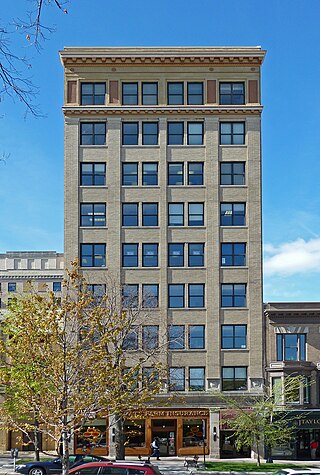
The Second Baptist Church, located at 441 Monroe Street within Greektown in Detroit, Michigan, is the oldest African-American church in the Midwestern United States. It was designated a Michigan State Historic Site in 1974 listed on the National Register of Historic Places in 1975.

Albert Kahn was an American industrial architect who designed industrial plant complexes such as the Ford River Rouge automobile complex. He designed the construction of Detroit skyscrapers and office buildings as well as mansions in the city suburbs. He led an organization of hundreds of architect associates and in 1937 designed 19% of all architect-designed industrial factories in the United States. Under a unique contract in 1929, Kahn established a design and training office in Moscow, sending twenty-five staff there to train Soviet architects and engineers, and to design hundreds of industrial buildings under their first five-year plan. They trained more than 4,000 architects and engineers using Kahn's concepts. In 1943, the Franklin Institute posthumously awarded Kahn the Frank P. Brown Medal.
Charles Nathanial Agree was an American architect in Detroit, Michigan.

This is a list of the National Register of Historic Places listings in Wayne County, Michigan.

The Brush Park Historic District is a neighborhood located in Detroit, Michigan. It is bounded by Mack Avenue on the north, Woodward Avenue on the west, Beaubien Street on the east, and the Fisher Freeway on the south. The Woodward East Historic District, a smaller historic district completely encompassed by the larger Brush Park neighborhood, is located on Alfred, Edmund, and Watson Streets, from Brush Street to John R. Street, and is recognized by the National Register of Historic Places.

The architecture of metropolitan Detroit continues to attract the attention of architects and preservationists alike. With one of the world's recognizable skylines, Detroit's waterfront panorama shows a variety of architectural styles. The post-modern neogothic spires of One Detroit Center refer to designs of the city's historic Art Deco skyscrapers. Together with the Renaissance Center, they form the city's distinctive skyline.

The Central Woodward Christian Church, now known as Historic Little Rock Missionary Baptist Church, is a Gothic Revival church located in Detroit, Michigan. It was listed on the National Register of Historic Places in 1993.

St. Joseph's Episcopal Church, now known as St. Matthew's-St. Joseph's Episcopal Church, is a historic Episcopal church located at 8850 Woodward Avenue in Detroit, Michigan, and is part of the Episcopal Diocese of Michigan. It was added to the National Register of Historic Places in 1982.

The Religious Structures of Woodward Avenue Thematic Resource (TR) is a multiple property submission to the National Register of Historic Places which was approved on August 3, 1982. The structures are located on Woodward Avenue in the cities of Detroit and Highland Park, Michigan.

The Wayne State University historic district consists of three buildings on 4735-4841 Cass Avenue in Midtown Detroit, Michigan: the Mackenzie House, Hilberry Theatre, and Old Main, all on the campus of Wayne State University. The buildings were designated a Michigan State Historic Site in 1957 and listed on the National Register of Historic Places in 1978.

The Park Shelton is a historic condominium building located at 15 East Kirby Street in Midtown Detroit, Michigan. Built in 1926 as The Wardell hotel, the building was therefore listed under this name in the National Register of Historic Places in 2007.

This is a list of the National Register of Historic Places listings in Detroit, Michigan.

The Cass Park Historic District is a historic district in Midtown Detroit, Michigan, consisting of 25 buildings along the streets of Temple, Ledyard, and 2nd, surrounding Cass Park. It was listed on the National Register of Historic Places in 2005 and designated a city of Detroit historic district in 2016.

The L. B. King and Company Building is a commercial building located at 1274 Library Street in Detroit, Michigan. It is also known as the Annis Furs Building. The building was listed on the National Register of Historic Places and designated a Michigan State Historic Site in 1987.

The Gethsemane Evangelical Lutheran Church is a church located at 4461 Twenty-Eighth Street in Detroit, Michigan. It was designated a Michigan State Historic Site in 1980 and listed on the National Register of Historic Places in 1982. The building now houses the Motor City Missionary Baptist Church.

The St. Stanislaus Bishop and Martyr Roman Catholic Church is a church located at 5818 Dubois Street in Detroit, Michigan. The church was listed on the National Register of Historic Places in 1989.

The Rosedale Gardens Historic District is a historic district located on eight streets, from Arden Street to Hubbard Street, between Plymouth Road and West Chicago Street in Livonia, Michigan. The district was placed on the National Register of Historic Places in 2010.

This is a list of the National Register of Historic Places listings in Downtown and Midtown Detroit, Michigan. It is intended to be a complete list of the properties and districts on the National Register of Historic Places in Downtown and Midtown neighborhoods in Detroit, Michigan, United States. Latitude and longitude coordinates are provided for many National Register properties and districts; these locations may be seen together in online maps.

George DeWitt Mason was an American architect who practiced in Detroit, Michigan, in the latter part of the 19th and early decades of the 20th centuries.

Law, Law & Potter was an architecture firm in Madison, Wisconsin; Potter Lawson, Inc. is its modern-day successor. Some of its buildings are listed on the U.S. National Register of Historic Places for their architecture. The firm was Madison's largest and "arguably most important" architectural firm in the 1920s and 1930s.